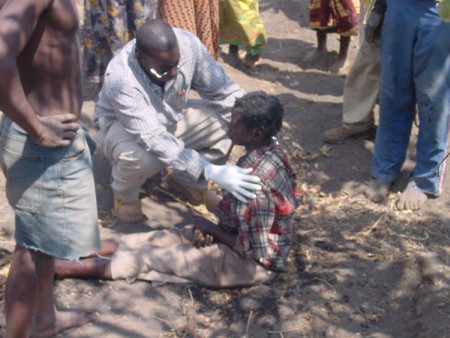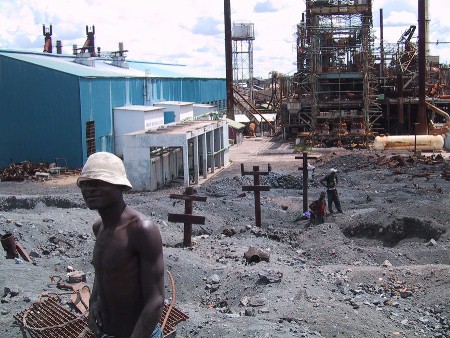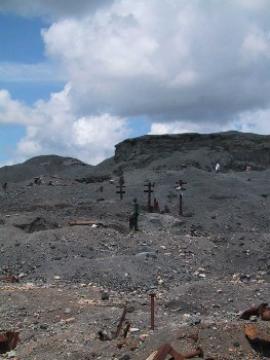Kabwe, Zambia
- Potentially Affected People: 255,000
- Type of Pollutants: Lead, cadmium
- Source of Pollution: Lead mining and processing
The Problem
Kabwe, Zambia, is located about 150 kilometres north of the nation's capital, Lusaka, and is one of six towns in close proximity to the Copperbelt, once Zambia's thriving industrial base. In 1902, rich deposits of zinc and lead were discovered there. Mining and smelting commenced soon after and ran almost continuously until 1994 without addressing the potential dangers of lead contamination. The mine and smelter are no longer operating but have left a city poisoned by debilitating concentrations of lead dust in the soil and by metals in the water. In one study, the dispersal in soils of lead, cadmium, copper, and zinc extended over a 20 km radius at levels much higher than those recommended by the World Health Organization.
A small waterway runs from the mine to the center of town and has been used to carry waste from the once active smelter. There are no safeguards or restrictions on use of the waterway and local children use it for bathing. In addition to contaminated water, dry, dusty, lead-laced soils near workers. home are a significant source of contamination for the locals. Most workers and residents are exposed to toxic levels of lead through inhaling dust in these areas.
Health Impacts
In some neighbourhoods in Kabwe, blood concentrations of 200 µg/dl or more have been recorded in children and records show average blood levels of children range between 50 and 100 µg/dl. On average, children's blood lead levels in Kabwe are 5 to 10 times the permissible EPA maximum and in many cases are close to those regarded as potentially fatal. Children who play in the soil and young men who scavenge the mines for scraps of metal are most susceptible to lead produced by the mine and smelter.
Status of Clean-Up Activity
After decades of widespread contamination, the clean-up strategy for Kabwe is complex and implementation is in its primary stages. Blacksmith has helped by supporting a local NGO (KERF) to bring information and educational services on lead poisoning into the local communities. Measures include simple, concrete advice to avoid poisoning, such as prohibiting children from playing in the dirt and rinsing dust from plates and food. However some areas of Kabwe require drastic remediation and entire neighbourhoods may need to relocate.
In response to local initiatives initiated by Blacksmith, the World Bank has allocated about US $40 million under the Zambia Copperbelt Environmental Project (CEP) to clean up waste and to resettle people living in hazardous areas of the Copper Belt region. CEP also received a $10 million grant from the Nordic Development Fund (NDF). Work is expected to commence soon and real health benefits should then begin to be seen. This followed a 2006 Kabwe scoping and design study conducted by Water Management Consultants for the World Bank which outlined the massive and debilitating health impacts suffered by the local community in Kabwe due to lead levels in the environment far exceeding any acceptable international standards.
Resources
"The Silent Death: Lead Poisoning in Kabwe, Zambia" Blacksmith Institute. 2001.
Penny Dale. "Zambia's child poisoning tragedy" BBC, Nov. 6, 2003.
B. Leteinturier, J. Laroche, J. Matera, and F. Malaisse. "Reclamation of lead/zinc processing wastes at Kabwe, Zambia: a phytogeochemical approach". South Africaln Journal of Science 97 Nov/Dec (2001) 624-627.
B. D. Tembo, K Sichilongo, J. Cernak. "Distribution of copper, lead, cadmium, and zinc concentrations in soils around Kabwe town in Zambia". Chemosphere (2006) 63 497-501.
Water Management Consultants, ZCCM Investments Holdings PLC, and Copperbelt Environment Project. Kabwe Scoping & Design Study, Project Synthesis. May 2006.
Additional Photos
 |
A health worker examines to a man sickened from scavenging in the lead mines of Kabwe, Zambia. Photo Credit: Blacksmith Institute |
 |
Young men look for metal at the site of an abandoned lead mine in Kabwe, Zambia. Lead poisoning of children in the area is endemic. Photo Credit: Blacksmith Institute |




